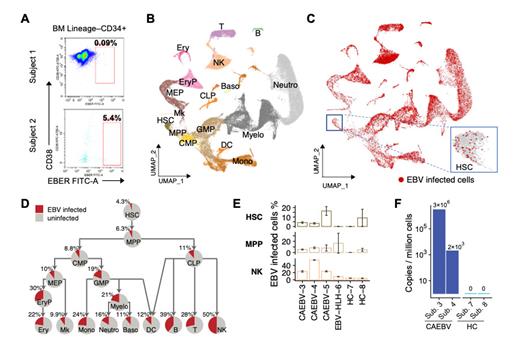Background Chronic active Epstein-Barr Virus (EBV) disease (CAEBV) is lethal syndrome due to persistent EBV infection. When diagnosed as CAEBV, EBV infection was observed in multiple hematopoietic lineages, but the etiology of CAEBV is still elusive.
Methods Bone marrow and peripheral cells derived from five CAEBV patients, one EBV-associated hemophagocytic lymphohistiocytosis (EBV-HLH) patient, and two healthy controls were analyzed. Multiple assays were applied to identify and characterize EBV-infected cells, including quantitative PCR (qPCR), PrimeFlow and single-cell RNA-sequencing (scRNA-seq). Based on scRNA-seq data, alterations in gene expression of particular cell types were analyzed between CAEBV patients and controls, and between infected and uninfected cells. One CAEBV patient was treated with allogeneic hematopoietic stem cell transplantation (HSCT), and the samples derived from this patient were analyzed again six month after HSCT.
Results EBV infected the full spectrum of the hematopoietic system including both lymphoid and myeloid lineages, so as hematopoietic stem cells (HSCs) in the CAEBV patients. EBV-infected HSCs exhibited a higher differentiation rate towards downstream lineages, and the EBV infection had an impact on both the innate and adaptive immunity, resulting in inflammatory symptoms. EBV infected cells were thoroughly removed from the hematopoietic system after HSCT.
Conclusions Token together,multiple lines of evidence presented in this study suggest that CAEBV disease originates from the infected hematopoietic stem cells.
Figure 1. EBV-infected HSCs were detected in CAEBV patients with multiple assays.
Disclosures
No relevant conflicts of interest to declare.


This feature is available to Subscribers Only
Sign In or Create an Account Close Modal